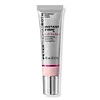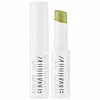What's inside
What's inside
 Key Ingredients
Key Ingredients

 Benefits
Benefits

 Concerns
Concerns

 Ingredients Side-by-side
Ingredients Side-by-side

Polyisobutene
Squalane
EmollientC12-15 Alkyl Benzoate
AntimicrobialHydrogenated Polydecene
EmollientOctyldodecanol
EmollientHelianthus Annuus Seed Wax
Skin ConditioningSimmondsia Chinensis Seed Oil
EmollientVinyl Dimethicone/Lauryl Dimethicone Crosspolymer
Theobroma Cacao Seed Butter
EmollientTribehenin
EmollientEthylhexyl Palmitate
EmollientCocos Nucifera Oil
MaskingSilica
AbrasiveCaprylic/Capric Triglyceride
MaskingPrunus Amygdalus Dulcis Oil
Skin ConditioningPunica Granatum Seed Oil
EmollientButyrospermum Parkii Butter
Skin ConditioningDipalmitoyl Hydroxyproline
Skin ConditioningPalmitoyl Tripeptide-1
Skin ConditioningSesamum Indicum Seed Extract
Skin ConditioningGlucomannan
Skin ConditioningDimethyl Isosorbide
SolventGlyceryl Caprylate
EmollientLinoleic Acid
CleansingTocopheryl Acetate
AntioxidantPalmitic Acid
EmollientMentha Piperita Oil
MaskingTocopherol
AntioxidantSodium Hyaluronate
HumectantCapsicum Frutescens Fruit Extract
Skin ConditioningLinolenic Acid
CleansingTrihydroxystearin
Skin ConditioningSorbitan Isostearate
EmulsifyingCoco-Caprylate/Caprate
EmollientGlyceryl Undecylenate
EmollientPolyhydroxystearic Acid
EmulsifyingPolyglyceryl-6 Polyricinoleate
EmulsifyingDilinoleic Acid/Butanediol Copolymer
Disodium Stearoyl Glutamate
CleansingWater
Skin ConditioningCastor Oil/Ipdi Copolymer
Mica
Cosmetic ColorantTin Oxide
AbrasiveTitanium Dioxide
Cosmetic ColorantIron Oxides
Polyisobutene, Squalane, C12-15 Alkyl Benzoate, Hydrogenated Polydecene, Octyldodecanol, Helianthus Annuus Seed Wax, Simmondsia Chinensis Seed Oil, Vinyl Dimethicone/Lauryl Dimethicone Crosspolymer, Theobroma Cacao Seed Butter, Tribehenin, Ethylhexyl Palmitate, Cocos Nucifera Oil, Silica, Caprylic/Capric Triglyceride, Prunus Amygdalus Dulcis Oil, Punica Granatum Seed Oil, Butyrospermum Parkii Butter, Dipalmitoyl Hydroxyproline, Palmitoyl Tripeptide-1, Sesamum Indicum Seed Extract, Glucomannan, Dimethyl Isosorbide, Glyceryl Caprylate, Linoleic Acid, Tocopheryl Acetate, Palmitic Acid, Mentha Piperita Oil, Tocopherol, Sodium Hyaluronate, Capsicum Frutescens Fruit Extract, Linolenic Acid, Trihydroxystearin, Sorbitan Isostearate, Coco-Caprylate/Caprate, Glyceryl Undecylenate, Polyhydroxystearic Acid, Polyglyceryl-6 Polyricinoleate, Dilinoleic Acid/Butanediol Copolymer, Disodium Stearoyl Glutamate, Water, Castor Oil/Ipdi Copolymer, Mica, Tin Oxide, Titanium Dioxide, Iron Oxides
Olea Europaea Fruit Oil
MaskingBis-Diglyceryl Polyacyladipate-2
EmollientSilica
AbrasiveSimmondsia Chinensis Seed Oil
EmollientButyrospermum Parkii Butter
Skin ConditioningHydrogenated Polyisobutene
EmollientHelianthus Annuus Seed Wax
Skin ConditioningPhytosteryl/Octyldodecyl Lauroyl Glutamate
Skin ConditioningMango Butter Dimer Dilinoleyl Esters/Dimer Dilinoleate Copolymer
EmollientMoringa Oil/Hydrogenated Moringa Oil Esters
Skin ConditioningPolyglyceryl-10 Pentaisostearate
EmollientCocos Nucifera Oil
MaskingHydrogenated Castor Oil Dimer Dilinoleate
Skin ConditioningCaprylic/Capric Triglyceride
MaskingC10-18 Triglycerides
EmollientLauryl Laurate
Skin ConditioningPolyhydroxystearic Acid
EmulsifyingTribehenin
EmollientHydrogenated Vegetable Oil
EmollientJojoba Esters
EmollientParfum
MaskingMentha Piperita Oil
MaskingTheobroma Cacao Seed Butter
EmollientCannabis Sativa Seed Oil
EmollientCannabis Sativa Seed Extract
EmollientRosmarinus Officinalis Leaf Extract
AntimicrobialStevia Rebaudiana Extract
Acacia Decurrens Flower Wax
EmollientPolyglycerin-3
HumectantTocopheryl Acetate
AntioxidantHelianthus Annuus Seed Oil
EmollientQuercetin
AntioxidantTocopherol
AntioxidantCitral
PerfumingGeraniol
PerfumingLimonene
PerfumingLinalool
PerfumingMica
Cosmetic ColorantCI 77492
Cosmetic ColorantCI 19140
Cosmetic ColorantCI 42090
Cosmetic ColorantOlea Europaea Fruit Oil, Bis-Diglyceryl Polyacyladipate-2, Silica, Simmondsia Chinensis Seed Oil, Butyrospermum Parkii Butter, Hydrogenated Polyisobutene, Helianthus Annuus Seed Wax, Phytosteryl/Octyldodecyl Lauroyl Glutamate, Mango Butter Dimer Dilinoleyl Esters/Dimer Dilinoleate Copolymer, Moringa Oil/Hydrogenated Moringa Oil Esters, Polyglyceryl-10 Pentaisostearate, Cocos Nucifera Oil, Hydrogenated Castor Oil Dimer Dilinoleate, Caprylic/Capric Triglyceride, C10-18 Triglycerides, Lauryl Laurate, Polyhydroxystearic Acid, Tribehenin, Hydrogenated Vegetable Oil, Jojoba Esters, Parfum, Mentha Piperita Oil, Theobroma Cacao Seed Butter, Cannabis Sativa Seed Oil, Cannabis Sativa Seed Extract, Rosmarinus Officinalis Leaf Extract, Stevia Rebaudiana Extract, Acacia Decurrens Flower Wax, Polyglycerin-3, Tocopheryl Acetate, Helianthus Annuus Seed Oil, Quercetin, Tocopherol, Citral, Geraniol, Limonene, Linalool, Mica, CI 77492, CI 19140, CI 42090
Ingredients Explained
These ingredients are found in both products.
Ingredients higher up in an ingredient list are typically present in a larger amount.
This ingredient is also known as shea butter. It is an effective skin hydrator and emollient.
Emollients help soothe and soften your skin. It does this by creating a protective film on your skin. This barrier helps trap moisture and keeps your skin hydrated. Emollients may be effective at treating dry or itchy skin.
Shea butter is rich in antioxidants. Antioxidants help fight free-radicals, or molecules that may harm the body. It is also full of fatty acids including stearic acid and linoleic acid. These acids help replenish the skin and keep skin moisturized.
While Shea Butter has an SPF rating of about 3-4, it is not a sunscreen replacement.
Shea butter may not be fungal acne safe. We recommend speaking with a professional if you have any concerns.
Learn more about Butyrospermum Parkii ButterThis ingredient is an emollient, solvent, and texture enhancer. It is considered a skin-softener by helping the skin prevent moisture loss.
It helps thicken a product's formula and makes it easier to spread by dissolving clumping compounds.
Caprylic Triglyceride is made by combining glycerin with coconut oil, forming a clear liquid.
While there is an assumption Caprylic Triglyceride can clog pores due to it being derived from coconut oil, there is no research supporting this.
Learn more about Caprylic/Capric TriglycerideCocos Nucifera Oil is obtained from the kernels of the coconut fruit. In other words, this is coconut oil.
Coconut Oil is rich in fatty acids with lauric acid making up the majority of these. It also contains linoleic acid. Due to this high fatty acid content, coconut oil helps trap moisture and soften skin.
Despite being antibacterial, coconut oil may not be great for acne-prone skin. It is comedogenic and may clog pores. This ingredient may not be safe for malassezia or fungal acne.
Note: Coconut Oil should not replace your sunscreen for UV protection. Studies show it only blocks about 20% of UV.
This oil is non-volatile and has a light scent.
The term 'fragrance' is not regulated in many countries. In many cases, it is up to the brand to define this term. For instance, many brands choose to label themselves as "fragrance-free" because they are not using synthetic fragrances. However, their products may still contain ingredients such as essential oils that are considered a fragrance.
Learn more about Cocos Nucifera OilHelianthus Annuus Seed Wax is created from the common sunflower.
Sunflower seed wax is made up of long chain non-glyceride esters, a small amount of fatty alcohols, and fatty acids.
This ingredient is often used to enhance the texture of products. The fatty acid properties also help hydrate the skin.
Learn more about Helianthus Annuus Seed WaxMentha Piperita Oil is the volatile oil obtained from the whole plant of the Peppermint plant.
It can be used to add a fresh scent to products.
Peppermint oil may cause skin sensitivity and redness due to its menthol content. Menthol also has a cooling effect (like your toothpaste).
Learn more about Mentha Piperita OilMica is a naturally occurring mineral used to add shimmer and color in cosmetics. It can also help improve the texture of a product or give it an opaque, white/silver color.
Serecite is the name for very fine but ragged grains of mica.
This ingredient is often coated with metal oxides like titanium dioxide. Trace amounts of heavy metals may be found in mica, but these metals are not harmful in our personal products.
Mica has been used since prehistoric times throughout the world. Ancient Egyptian, Indian, Greek, Roman, Aztec, and Chinese civilizations have used mica.
Learn more about MicaPolyhydroxystearic Acid is a soft wax made from castor oil.
It is is a texture thickener, emulsifier, and film-former. Emulsifiers prevent ingredients from separating, such as oils and waters.
Polyhydroxystearic Acid may not be fungal acne safe.
Learn more about Polyhydroxystearic AcidSilica, also known as silicon dioxide, is a naturally occurring mineral. It is used as a fine, spherical, and porous powder in cosmetics.
Though it has exfoliant properties, the function of silica varies depending on the product.
The unique structure of silica enhances the spreadability and adds smoothness, making it a great texture enhancer.
It is also used as an active carrier, emulsifier, and mattifier due to its ability to absorb excess oil.
In some products, tiny microneedles called spicules are made from silica or hydrolyzed sponge. When you rub them in, they lightly polish away dead skin layers and enhance the penetration of active ingredients.
Learn more about SilicaThis oil comes from the seeds of the desert shrub called Jojoba. It is more commonly known as jojoba oil, a non-comedogenic oil.
Jojoba oil does not contain fragrance and has many fatty-acids, making it a great soothing ingredient.
It also contains Vitamin E, a great moisturizing ingredient. Vitamin E is also an antioxidant and protects your skin against oxidative damage.
This ingredient humectant properties, meaning it helps draw moisture from the air. This helps keep your skin hydrated.
While jojoba has antibacterial properties, it is only able to kill some strains of bacteria.
Studies also show it helps in wound healing. In fact, Indigenous cultures have used jojoba as a moisturizer and to help treat burns for centuries.
Fun fact: Jojoba oil similar to natural human skin sebum, so it has a great effect on dry skin. It is also promising with helping to regulate sebum production.
Due to its fatty acid content, Jojoba oil may not be fungal acne safe. We recommend speaking with a professional if you have any concerns.
Learn more about Simmondsia Chinensis Seed OilTheobroma Cacao Seed Butter comes from the Theobroma cacoa, or Cacao tree. Cacao trees are native to tropical landscapes.
Like other plant butters, Cacao seed butter is an emollient. Emollients help soothe and soften your skin. By creating a barrier to trap moisture in, emollients help keep your skin hydrated.
Cacao seed butter contains antioxidants known as polyphenols. Antioxidants help fight free-radical molecules by stabilizing them. Unstable free-radicals may cause damage to your skin cells. Antioxidants may help with anti-aging.
Theobroma Cacao Seed Butter can be bad for acne prone skin.
Learn more about Theobroma Cacao Seed ButterTocopherol (also known as Vitamin E) is a common antioxidant used to help protect the skin from free-radicals and strengthen the skin barrier. It's also fat soluble - this means our skin is great at absorbing it.
Vitamin E also helps keep your natural skin lipids healthy. Your lipid skin barrier naturally consists of lipids, ceramides, and fatty acids. Vitamin E offers extra protection for your skin’s lipid barrier, keeping your skin healthy and nourished.
Another benefit is a bit of UV protection. Vitamin E helps reduce the damage caused by UVB rays. (It should not replace your sunscreen). Combining it with Vitamin C can decrease sunburned cells and hyperpigmentation after UV exposure.
You might have noticed Vitamin E + C often paired together. This is because it is great at stabilizing Vitamin C. Using the two together helps increase the effectiveness of both ingredients.
There are often claims that Vitamin E can reduce/prevent scarring, but these claims haven't been confirmed by scientific research.
Learn more about TocopherolTocopheryl Acetate is AKA Vitamin E. It is an antioxidant and protects your skin from free radicals. Free radicals damage the skin by breaking down collagen.
One study found using Tocopheryl Acetate with Vitamin C decreased the number of sunburned cells.
Tocopheryl Acetate is commonly found in both skincare and dietary supplements.
Learn more about Tocopheryl AcetateTribehenin comes from glycerin and behenic acid.
It is used as an emollient, or moisturizer. Emollients form a thin barrier on skin to prevent moisture from escaping.
This ingredient may not be Malassezia folliculitis, or fungal-acne safe.
Learn more about Tribehenin